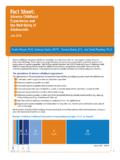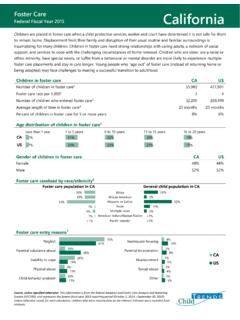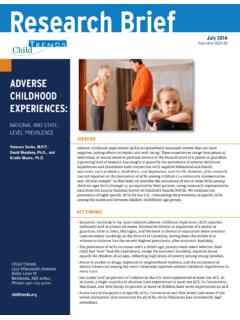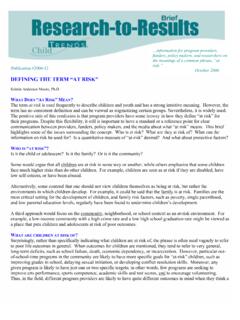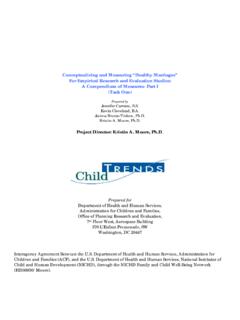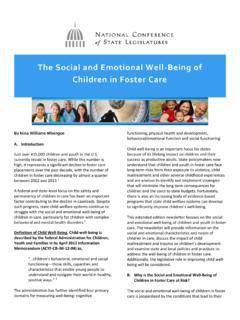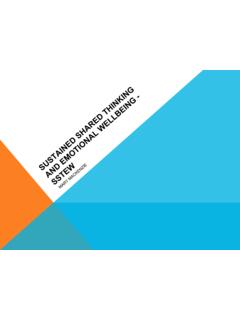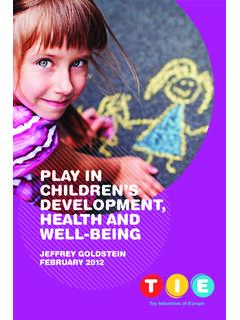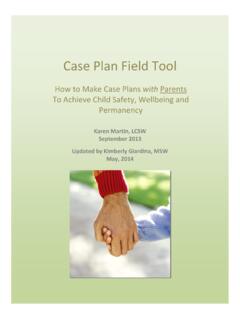Transcription of Child Well-Being - Child Trends
1 1 Child Well-Being : Constructs to Measure Child Well-Being and Risk and Protective Factors that Affect the Development of Young Children June 2016 Child Trends 2 Authors Child Trends staff who worked on this white paper include: Kristin Anderson Moore, Project Director David Murphey Martha Beltz Miranda Carver Martin Jess Bartlett Selma Caal Acknowledgments Child Trends would like to acknowledge Doris Duke Charitable Foundation for funding this project, Rosemary Chalk and Lola Adedokun for providing thoughtful reviews, and John Lingan for helpful editing. Child Trends Publication #2016-61 3 Contents Executive Summary .. 4 Chapter 1: Introduction and Background .. 12 I. Introduction .. 12 II. Key concepts and themes in this review .. 18 Child Well-Being .. 18 Risk and promotive/protective factors .. 18 Themes affecting conceptualization and measurement in Child 20 Chapter 2: Child Well-Being .. 24 I. Domains .. 24 Cognitive and academic development.
2 25 Socio-emotional/psychological development .. 28 Social behaviors .. 32 Physical health and safety .. 33 Relationships .. 36 II. Summary .. 38 Chapter 3: Risk and Protective Factors .. 41 I. Environmental promotive/protective factors .. 42 Family/relational promotive and protective factors .. 43 Contextual/community promotive and protective factors .. 51 II. Risk factors .. 52 Family/relational risk factors .. 54 Contextual/community risk factors .. 60 III. Discussion .. 62 Chapter 4: Supports and Services .. 64 Chapter 5: Conclusions and Implications .. 71 A broad perspective on Child Well-Being .. 71 Measurement issues that need to be addressed .. 73 Potential next steps .. 75 Conclusion .. 76 4 Executive Summary Purpose What is flourishing in a young Child ? How can we know whether a Child is flourishing? And, what does it take for a Child to flourish? Unfortunately, researchers and policy makers tend to focus on problems, dangers, and risks.
3 Very little attention is paid to thriving that is, positive behaviors, learning, and emotions -- and resilience in the face of challenges. Negative outcomes are, of course, important to understand, but an exclusive focus on them offers an incomplete view of Child development. As shown in Figure 1, this white paper focuses on Child Well-Being , and highlights positive outcomes, not just negative aspects of Well-Being . We also identify risk and protective factors, and we provide brief summaries, drawn from the research literature, of associations among the various factors and with the Child Well-Being constructs. The model is defined by a large arrow that reflects the life course model of development, where Child Well-Being is both a goal (outcome), and a process that unfolds over time. Figure 1: Conceptual model of the determinants of Child Well-Being 5 In this paper, we propose a set of Child Well-Being constructs (factors that represent important dimensions of Child development) for children ages 0 to 8.
4 We also explore the various factors that can affect these outcomes, and suggest strategies for intervention. More work is needed, however, to develop the specific measures required to measure Child flourishing and to assess progress toward these Child Well-Being goals. Our primary goals are to focus on flourishing and to incorporate the critical recognition that positive as well as negative outcomes need to be conceptualized and measured. The intention is also to flag the critical promotive and protective factors that contribute to positive development, not simply factors that represent potential precursors of poor outcomes for young children, so that measures of these factors can be developed. These measures can then be used to monitor Child Well-Being among vulnerable children. Risks to children s development are undoubtedly important to understand and address, but promotive and protective factors are frequently overlooked in existing data collection systems. Programs and policies need to not only reduce risks, but also build and support protective factors.
5 A set of valid measures could help communities identify the assets/strengths already present in their children and families, and provide a platform on which to build additional supports. Theories and themes This review draws on several widely accepted perspectives in the Child development field. While we recognize that individual Well-Being is a product of interactions between one s genetic program and a particular environment, we give particular attention to the multiple environments and domains that affect positive development. Ecological theory, for example, recognizes the importance of the family and community, along with Child characteristics, in affecting children s development, while the whole Child perspective posits the interactivity of all domains of Child outcomes, including cognitive, socio-emotional, social behaviors, physical health, and relationships. As noted, we draw on models of risk and protective factors to highlight the important reality that virtually all children, even those experiencing multiple challenges, have protective factors and assets within their families , communities , and themselves.
6 6 Domain: The highest and broadest category of Child Well-Being elements. Constructs: The factors or elements of Child Well-Being within a domain that comprise that domain Measures: The actual tools used to assess a construct: this includes scales, indices, observational codes, etc. Items: The individual questions or checklist codes that comprise A number of additional themes appear throughout the paper. One theme is that Well-Being occurs along a continuum. Also, outcomes are dynamic and in progress. That is, outcomes at one age contribute to outcomes at subsequent stages. In addition, as implied by the feedback arrows in Figure 1, developments at one age can trigger risk and protective factors as well as supports, services, and even contexts, if a Child s outcomes lead to a change in context ( , moving to a new neighborhood or changing schools). At the same time, cumulative disadvantages increase developmental challenges. Also, while many individual and social factors are effectively non-malleable, their importance needs to be recognized in conceptual models and measurement strategies, as well as policy and program initiatives.
7 These theories and themes underlie Child development research and are critical for understanding the development of vulnerable young children. A whole- Child perspective on Child Well-Being As noted, this paper takes a whole Child perspective. Much research on children takes place within silos, where researchers consider a single area of development. For example, education researchers focus on cognitive development and academic attainment, while health researchers typically focus on physical health. If we are to understand how to foster flourishing children, we need more integrative work that addresses the Child across all five developmental domains education, health, social behavior, psychological/ emotional development, and relationships. However, questions of causality and sometimes even the direction of relationship often remain unresolved. For the purposes of this review, these five domains organize our identification of constructs that call for improved measurement in studies of young children facing adversity.
8 (By constructs , we mean the categories of behaviors, attitudes, knowledge, and emotions that Child development research has identified and classified with a common label.) The constructs identified within the five Well-Being domains are depicted below and discussed in Chapter 2 of the white paper. 7 Table A: Constructs (factors) that have been found to comprise Child development in each of the domains of Child Well-Being Child Well-Being domain Constructs Cognitive and academic development Language development Early academic skills Age-appropriate general knowledge Engagement in learning/approaches to learning; problems with concentration/focus Executive functioning Learning difficulties Developmental delay Socio-emotional/ psychological development Emotion understanding Self-regulation, positive coping Depression/anxiety disorders, PTSD Self-efficacy; mastery Planning for the future Social behaviors Social skills/global social competence Behavior problems, including aggression, oppositional/defiant disorder and bullying Physical health and safety Overall health status Special health care needs/ chronic conditions Growth and weight Physical safety Stress-related disorders (hormonal, metabolic, immunologic) Sleep problems Age appropriate self-care Relationships Safe, stable, and nurturing relationships (SSNRs) with caregivers Caregiver- Child attachment Positive relationships with trustworthy non-parent adults Positive peer relationships Bonding/ bridging social capital As a next step, it will be necessary to compare these constructs with the constructs and measures included in databases such as the Early Childhood Longitudinal Survey Birth and Kindergarten Cohorts and the National Survey of Child and Adolescent Well-Being , as well as measures used in community studies and clinical screeners.
9 While it is important to assess how these constructs are already measured, it is also important to identify constructs that are not currently measured. For example, for 8 vulnerable children, it may not be sufficient to ask about closeness and support from parents alone, but about an array of additional persons who may buffer hardship or mistreatment. Also, it is important to assess the response categories. Is there sufficient variation in the response categories to capture serious problems and to identify change over time? For example, response categories that record never, sometimes, and always may be inadequate to capture behavioral frequencies. Risk and promotive/protective factors Our review has sought to identify both positive and negative correlates of children s developmental trajectories; and the value of including both risk and protective constructs is an important implication of this work. Another implication of a focus on promotive and preventive factors is an emphasis on prevention.
10 While treatment is necessary and needs to be a priority, prevention is less costly in every sense of the word. Understanding and monitoring the presence of promotive and preventive factors represents an important element in a prevention strategy. This point is reviewed in Chapter 3. Table B: Promotive/protective constructs (factors) that affect children s development, across relational/family, and contextual/community levels Promotive/Protective factor level Constructs Relational/family Family support for children s executive functioning Caregiver/adult responsiveness Caregiver/adult warmth Shared family activities Control over the number and timing of children in the family Parent/caregiver engagement with school and community Safe and supportive home environment Family routines Stimulating home environment Parenting skills and attributes ( authoritative style) Religious involvement Enduring presence and positive support of caring adults and kin Contextual/community Relevant, high-quality, culturally appropriate available local services Safe and healthy school environment Safe and cohesive neighborhoods, safe housing 9 Table C.
